Origins: Monsoon Wedding in Lahore; Golden Temple in Amritsar; Friends in New Delhi AND Good Food Everywhere
Monsoon Wedding in Lahore
“You’re going to Pakistan? Whooo, I wouldn’t go there” is the reaction I got from friends when I mentioned that I was going to Lahore to attend the wedding of a friend’s daughter. Although I’d visited 10 years ago for his son’s wedding and enjoyed my stay, I got a little anxious as both my national affiliations are targets for local terrorists. We met more than 40 years ago as fellow doctoral students at Stanford and have remained friends through the twists and turns of life and challenges of geography. Being present at major life-events means a lot in the South Asian tradition. My friends reassured me that they host visitors from India and the US for work regularly and, in any case, I would not stand out because I look like a local.
Pakistan gets a bum rap from the media in the US that concentrates on terrorist attacks and political unrest, often calling it a failed state. But those issues have abated and the country is growing at a good clip of 4-5 percent per annum, poised to enjoy stable progress.
Although the partition of the subcontinent into Pakistan, India and Bangladesh is a done deal, I’m not sure I’ve accepted it at some deep emotional level. The tension between Pakistan and India has hobbled the growth and development of both and affected all of South Asia. If the cost were assessed at just .5 percent of GDP per year, with normal relations, both countries GDP would have been 40 percent higher today. In conversations I heard echoes of Obama’s policy change towards Cuba “after seventy years of a failed policy towards India, it’s time to take a new approach. ” I hope that happens, although it does not look probable.
As we were several foreign guests, my friends organized tours of Lahore during the day and our evenings were occupied with wedding events that lasted late into the night. The family is big, with eleven siblings between the two, their children and spouses, grandchildren, spouses families, friends, and so on. The Urdu-Hindustani word “Khandan” captures the fullness of the assembly better. There was absolutely no problem in fielding parties of two or three hundred: a dinner with traditional wedding songs and music; disco-dancing to hip-hop and bhangra music with a bar serving cocktails and a late dinner to revive energy; a dinner at a rooftop restaurant overlooking the Badshahi mosque in the old city; the wedding ceremony under a specially constructed tent in the garden; and finally, a reception at a fancy hotel. Restrictions on the sale of alcohol were not a barrier to its availability at most of these parties. Ironically, the disco-event with cocktails was held in the lobby of a modern office building where the Saudi Consulate issues visas for Hajj pilgrimages.
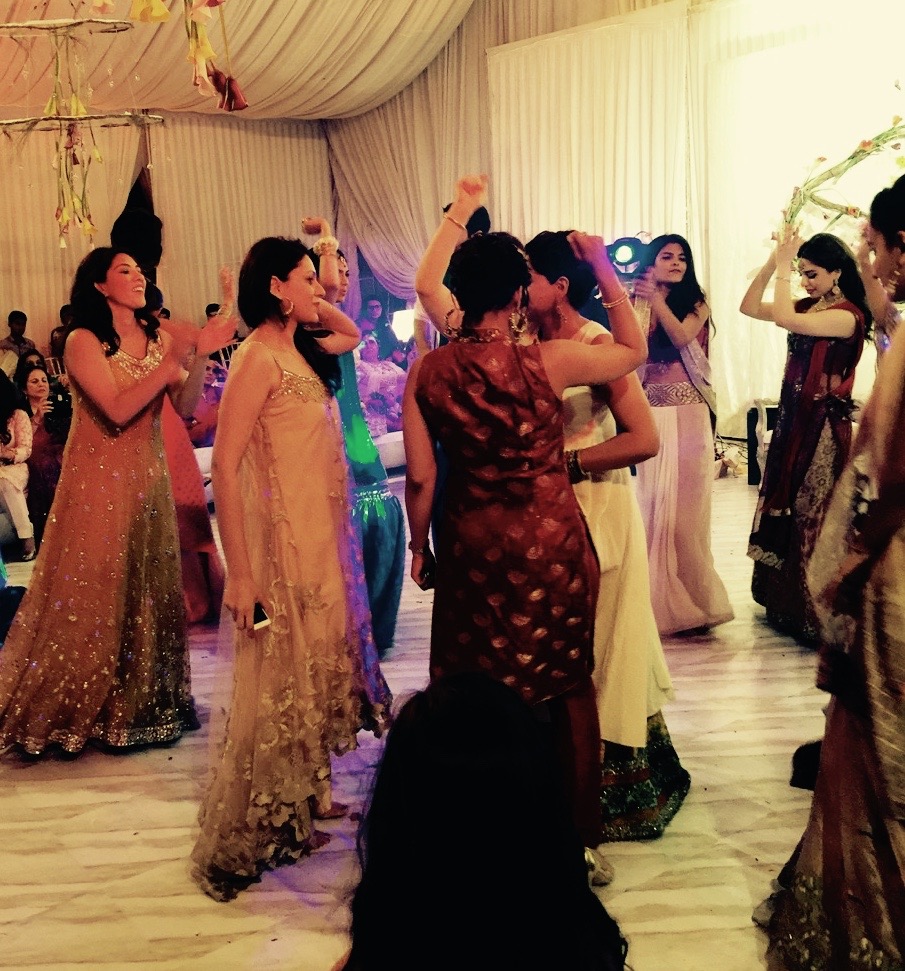
Dancing. Photo by Enjum Hamid
Although the festivities leading up to the wedding, and bride and groom’s dress, are similar for all religions in South Asia, the Muslim ceremony is different from the Hindu and much simpler. The Nikah is a formal binding contract that lays out the rights and responsibilities of the bride and groom in the context of family, friends and society. Helpfully, an explanation in English was provided before an Imam conducted the ceremony. Music, dancing and dinner followed and ended with the Rukhsati, when the bride leaves with the groom.

Exchange of Rings. Photo by Enjum Hamid
Lahore is a populous city with 10 million inhabitants and has been the historical capital of Punjab for about a millennium. It served in that capacity for the Moghul and British Empires and was the capital of the Sikh Empire between the two. Consequently, its architecture is a blend of those three traditions. Mall Road, named after the Mall in London, one of the main arteries, is littered with historic buildings on both sides including the museum, colleges and universities, library, post office, railway station and markets. My father’s office was in the commercial section that is architecturally similar to Connaught Place in Delhi.

Workshop in Old City, Lahore
We visited museums, mosques, galleries, the fort and the old city on successive days. Although the fort’s recorded history goes back to the 1200s, the current structure was rebuilt by Moghul Emperor Akbar (ruled 1556-1605 CE) and added to by his dynastic successors and Sikh Emperor Ranjit Singh (ruled 1801-1839 CE) and his successors as well. The Sheesh Mahal or palace of mirrors was the most remarkable building in the complex with pieces of mirror embedded in the walls of a spacious front hall and several behind. A marble screen in the rear chamber with floral patterns allows views of the old city and cool air to flow in. A small building housed paintings of Ranjit Singh and his last successor, Dilip Singh, a remarkably handsome man, and other artifacts purchased by the government from his daughter Princess Bamba.
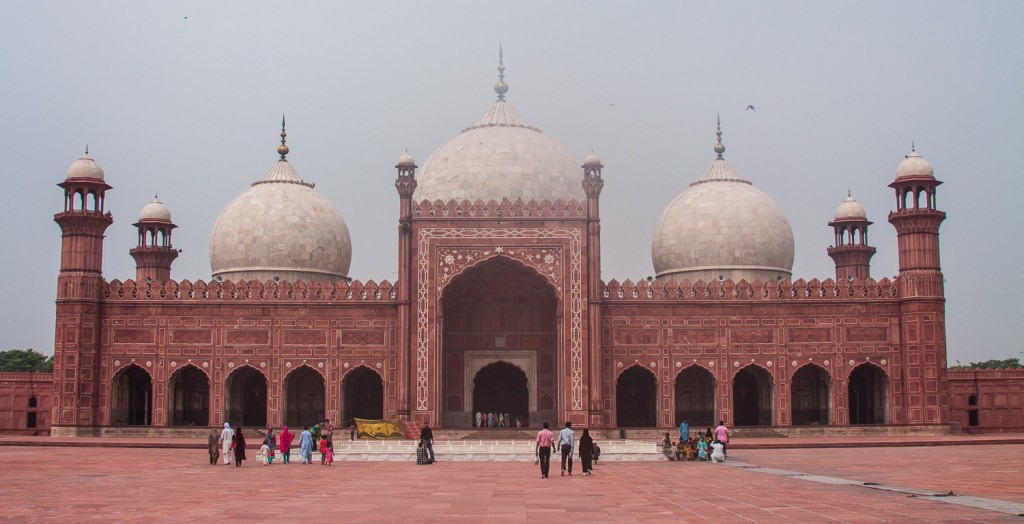
Badshahi Mosque, Lahore
The imposing Lahore museum, the biggest in the country, built in 1894, but is in need of renovation as the museum’s director, who welcomed us, pointed out. Among its 20 galleries, I appreciated the Gandharan sculptures, notably Ashoka’s lion capital, and the modern art, where Shakir Ali’s bold, abstract expressionist painting caught my attention. We saw a few miniature paintings with unbelievably fine work, some of it done with a single hair. The ancient coins from the Greek and Mauryan periods shown by the director of numismatics with a lively commentary were stunning. “May I see the Mauryan coin again, made by my ancestors?” I asked, jokingly referring to Emperor Ashoka. “Our ancestors too” the director replied. Rudyard Kipling’s father was an early curator of the museum. The bookshop on the grounds is named Kim’s to commemorate that association.
We had the privilege of a private viewing of the Faqir Khana museum with the voluble and interesting owner as our guide. His ancestors served Maharaja Ranjit Singh as Prime Minister and Royal Physician. The family house in the old city is crammed with artifacts, apparently 30,000, collected over generations, each with a fascinating history. Especially interesting were the subtle, layered miniature paintings on ivory, some Gandharan objects and a manuscript.
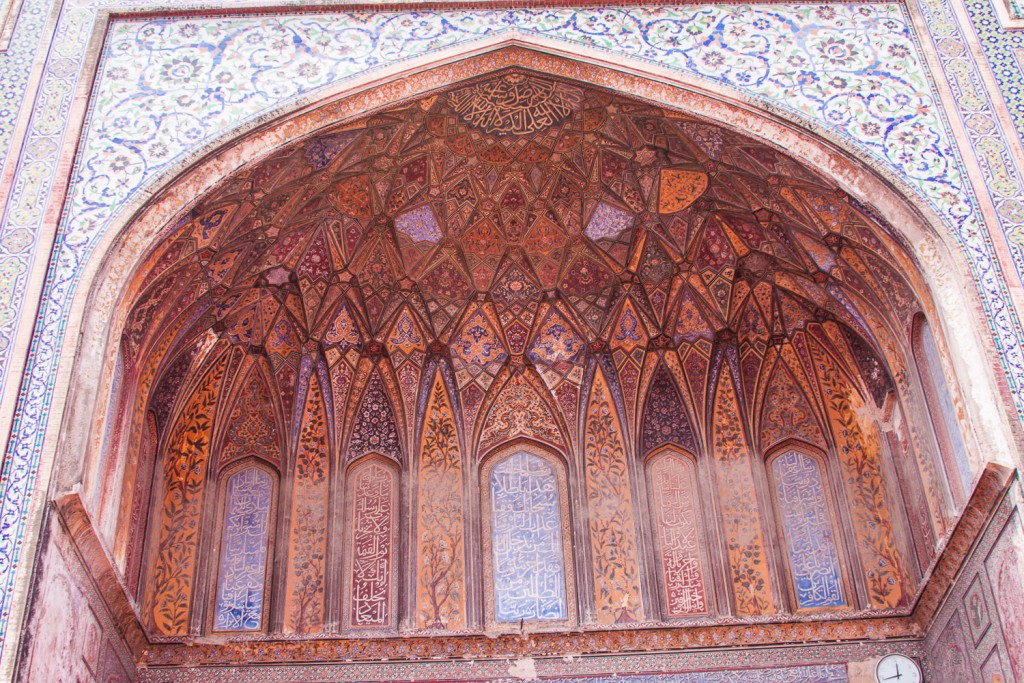
Entrance to Wazir Khan Mosque, Lahore
Wazir Khan was a healer and also great builder after he became the governor of Punjab under Emperor Shah Jahan (ruled 1628-1658 CE), best known for building the Taj Mahal. Wazir Khan built a mosque and public baths. The baths have 21 rooms including some for cold, hot and steam baths. Its walls have colorful frescos and the vaulted ceilings have intricate geometric designs. The Wazir Khan mosque is relatively small but beautifully proportioned and colorfully decorated with frescos, calligraphy and designs made from tile.
Emperor Aurangzeb (ruled 1658-1707 CE) built the huge Badshahi mosque adjoining the fort. Its brownstone courtyard can accommodate 100,000 worshippers and the main prayer chamber is divided into seven areas by engraved arches and topped by three domes. Though imposing in size, it is architecturally plainer than the Wazir Khan mosque.
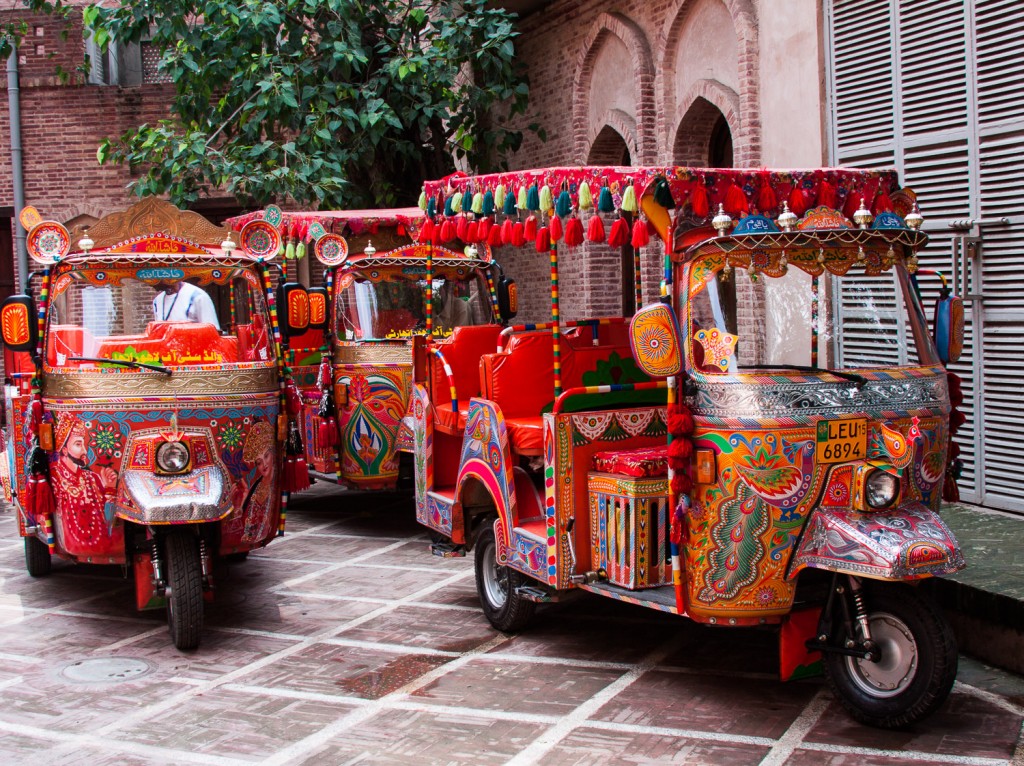
Transport in Old City, Lahore
Other tourist expeditions were to the museum dedicated to Shakir Ali’s paintings, actually his house until he passed away, but it was closed. We were luckier in visiting Komail Aijazuddin’s studio to see his delicate work playing with the concept of paintings on the margins of old books. He is a descendant of the Faqir family whose museum we visited.
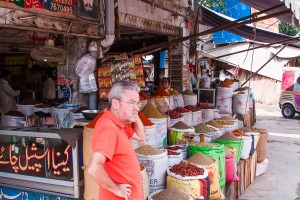
Spice Shop in Lahore
I have avoided looking into my origins in the belief that we make our path through life without positive or negative encumbrances from our ancestors. Before leaving the US, however, I heard an interview of an author of a book that presented a completely different view. His detailed analysis suggests that nature trumps nurture and a family’s history determines about 75 percent of its social standing for several hundred years.
I was born in Lahore, but lived there for just the first few months of my life as my father’s job took us to live in Delhi in 1940, well before the Pakistan was partitioned from India. My roots in Lahore may be slim, but my family’s are deep, going back for generations. My grandfather spent most of his life there and my father until his mid-thirties. I have photographs of them in Lahore. Much of the conversation I heard when I was young was wistful memories of life there, especially after partition when friends and acquaintances streamed into Delhi. I made an attempt to find the house where I was born with an address from my sister, now aged 86. I found the house number, but the description of the surroundings did not conform to her memory. Anyway, the houses in the area were huge so my beginning was comfortable.
Border Crossing at Wagah
After the wedding, two other guests and I traveled by car to the Indian border en route to Amritsar, which is just 30 miles away, but it took a long time to get there. Sunday traffic was light so we made good time to the border, but as we approached it, we were stopped four times, every few hundred yards, and had to show our passports. After the last viewing, we were dropped off in a large enclosure about the size of a football field. About 20 minutes later a toy train, like those in theme parks, took us to the Pakistani Customs and Immigration building where our passports were examined two more times. We then walked a hundred yards to the Indian border where our passports were checked twice. Then a bus took us to the Indian Customs and Immigration building where we filled out one form for immigration and two for customs and our passports were examined at both stops. In all, 10 people looked at our passports and the process took over an hour even though we were the only people crossing the border. A taxi took us into Amritsar city. In contrast to Lahore, the streets seemed noticeably messier.

Golden Temple
Of the two other travelers one was a Sikh and the other had the same surname as mine. With my origins lurking in my mind, we got into a discussion about our ancestors that neither of us knew much about. Later in the day I did a little digging. Khannas belong to the Khatri clan that considers itself of pure Vedic descent and therefore superior to other Kshatriyas, the caste for rulers, military officers and administrators. The clan had been in the Punjab for a long time as warriors and chieftains. Khatris served in the Moghul armies and one of them was Emperor Akbar’s finance minister, a Todar Mal Khanna. The clan had a dispute with Emperor Aurangzeb, Akbar’s great-grandson, about widow re-marriage and was subsequently excluded from the military and administration. As a substitute occupation, Khatris turned to business and trade and became important in the Empire in that capacity. Interestingly, all ten of the Sikh Gurus were Khatris as is Man Mohan Singh, the former Prime Minister of India. Also, there are Muslim Khatris, known as Khawaja or Punjabi Sheikhs.
Among the Khatris, the Khanna, Kapoor and Melhotra families, known as Dhai Gharas, or two and a half houses, also pre-existed the Moghuls, and intermarried within the group. They consider themselves descendants of Kshatriya Suryavanshi clans. For that reason, other such clans are sometimes included as Dhai Gharas for endogamy such as Seth and Tandon. I’m not sure what this means, but the only prominent Dhai Gharas I am aware of are several famous Bollywood actors named Kapoor and Khanna.
Golden Temple in Amritsar
Although I am not a religious person, I’ve had in mind to pay my respects at the Golden Temple, actually named Harmandir Sahib. As Amritsar is en route from Lahore to Delhi, this was a great opportunity to do so. I know nothing about the religion, except that it preaches equality and non-discrimination on the basis of caste, creed or gender. I do not recall much discussion of it when I was growing up, but my mother requested a Sikh funeral ceremony, soulful kirtan (hymn) music.
I visited at night, passed the crowded entrance, head covered with a saffron colored kerchief and bare feet cleaned in a shallow pond, and joined the procession along the causeway that connects to the lit up, striking gold temple that sits in the middle of a small lake fed by the Ravi River. Guru Arjan commissioned it in 1588 CE and a Sufi Iman, Hazrat Mian Ali, laid the foundation stone. A few centuries later, Maharaja Ranjit Singh placed the gold plate cover on the upper floors and the inner ceiling is also made with gold and precious stones. It has four entrances to signify openness. I sensed the piety of the people in line coming to pay their respects to the Guru Granth Sahib, the holiest text for Sikhs, kept in the inner sanctum. As we got closer, several worshippers crouched and made gestures of obeisance, but most just filed by with a moments pause and a namaste gesture with a bowed head.
Next to my newly built Hyatt Hotel, was a modern temple, the AlphaOne Mall. Advertised as a shopper’s paradise that offers a range of international and regional brands on three levels. Being Sunday, it was full of shoppers, mostly younger people, who may also have been attracted by the song and dance performance in the lobby. The top floor had a bunch of restaurants that included a Bar and another pub scheduled to open.
Friends in Delhi
My flight to Delhi was a short hop into a congested city of 30 million people. I stayed for 8 days with no special purpose except to spend time with friends, have a physical exam and dental work done, both thorough and cheap. I stayed at the Gymkhana Club as usual. I had also lodged at the Lahore Gymkhana. The similarity in the service and systems was striking. The legacy of the British club chit-signing system lives on in the sub-continent. The Lahore club was formed in 1878, 35 years before the Delhi club, but it was moved from its grand building on Mall Road, rather like the US President’s White House, to a new facility on its golf course. Despite new architecture, the lodging rooms were almost identical to those in the Delhi club.
Meeting and talking to friends from when I was in boarding school and university reminded me of where we started and how we have developed. More than half of my 22 boarding school class has fanned out all over the world, gone into diverse professions and lived interesting lives. I had contacted some by email from California to interest them in writing a class biography. With that objective in mind, I spoke to our Class Captain, yes there was such a person, who gave me telephone numbers of a few classmates in Calcutta and Mumbai. I spoke with several trying to interest them in the project.
Good Food Everywhere
I left India almost 60 years ago, but my love for Indian (South Asian) food has never left me, although there is now a caveat that I will come to. At my friend’s house in Lahore, the food was appetizing whether it was simple chick peas and semolina halva or a complex Burmese dish–noodles, curry, scallions, boiled eggs–or Italian antipasti salads catered by Cosa Nostra and the Chausa mangoes were suculently delicious. At Andaaz, a rooftop restaurant overlooking the Badshahi Mosque, the fish tikka, sour dal, roasted vegetables, pullau and gulab jamun were excellent with service to match. On the way into Amritsar, we stopped at Brothers Dhaba for lunch where the Kulcha was outstanding, crisp on the outside and soft on the inside.
In Delhi, as always I enjoyed my standard meal at the Gymkhana Club, a vegetarian thali that includes a paneer dish, two vegetables, dal, yogurt, rice and tandoori roti. Sitting in the Club’s café one morning, I chatted with an attractive, vivacious woman, an accomplished mountaineer and, fortuitously, a restaurant designer. I asked her for recommendations for a modern and traditional Indian restaurant. She suggested “Indian Accent” for the modern and “In the Punjab” for the traditional.

Indian Accent Papdi Pizza
“Indian Accent” has three cozy, simply decorated, but well-appointed dining rooms and Michelin Star level service. The award winning Executive Chef, Shantanu Mehrotra, said its theme is to maintain the integrity of Indian food, its ingredients and textures, modernize it, and introduce some international flavors. Before my appetizer arrived, I was served two small donut shaped naans stuffed with Italian blue cheese and sprinkled with roasted cashew nuts and coconut flakes. Using blue cheese was unusual and surprised my palate. A thimble of Sweet Corn Soup followed as an amuse bouche. My starter was a Papdi Pizza, basically chaat served on a pizza shaped flat round papdi presented on a square black slate plate, looking lonely. It had boiled potatoes, chick peas, pomegranate seeds sprinkled with chopped coriander leaves, tamarind and mint sauces, yogurt and other spices. The pizza crust was crisp and the ingredients fresh. After the first multifaceted taste, the spices were overpowering. The palate cleanser was a small sorbet cone made of pomegranates and churan (a mixture of cumin seed, dry mango powder, black pepper and salt, sugar and ginger, generally eaten as a digestive). As I had not tasted churan in a very long time, its flavors revived memories.
For my main dish I ordered the traditional Punjabi mustard and spinach greens, baked in a corn crust, instead of the traditional corn roti that comes with it, and fresh ricotta and butter curry. The baked pie crust kept the greens warm throughout, but once again, after the initial aromatic taste, it was too spicy, despite relief from the ricotta. The dish came with a thin, crisp naan, just how I like it.
I talked to the Chef about my reaction to his creations, imaginative, but the lingering spiciness too strong for a foreign palate. He acknowledged my comment and responded by offering me a dessert, Custard Apple Cream. Although I was full, I could not resist tasting one of my favorite fruits that is not widely available in the US. Thick, sweet, gooey spoonfuls were a delicious offset to the spicy meal.

Indian Accent After Dinner Tid Bits served on a mini charpai
I had lunch at “In the Punjab” with my great niece. We ordered the traditional Punjabi spinach greens, this time with paneer, and sweet, sour and spicy eggplant with a kulcha stuffed with potatoes and an unusual chur chur (crushed) naan. The food was good, especially the breads, the kulcha as good if not better than in Amritsar, but the spiciness after the first taste was overwhelming again despite dousing the food in plain yogurt.
Here’s the caveat: Although I still love South Asian cuisine, my taste buds, and probably a lot else, have adapted to the world’s cuisines and cultures, making me a “feranghi”, which means what it sounds like, a foreigner.
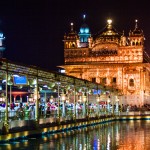

10 Responses to Origins: Monsoon Wedding in Lahore; Golden Temple in Amritsar; Friends in New Delhi AND Good Food Everywhere